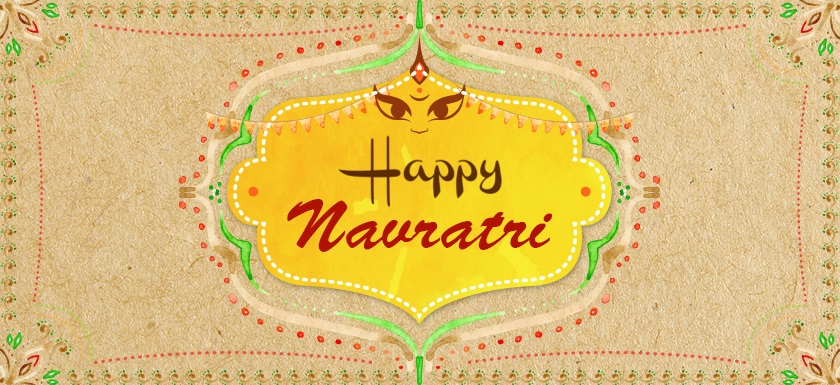


Happy Navratri 2019 - The Tradition, The History, The Ritual
Happy Navratri 2019:
Sharad Navaratri lasts for nine days. During this, nine forms of Maa Durga (Maa Durga) are worshiped. These are the nine forms - Shailputri, Brahmacharini, Chandraghanta, Kushmanda, Skandamata, Devi Katyayani, Kalratri, Mahagauri, and Siddhidatri. These days, devotees give each other good wishes and auspicious messages. People also pay their respects to Maa Durga on Facebook, Twitter, and Instagram. This is done by sharing the messages and messages of Navratri. So let us tell you that you can send your affection towards mother and best wishes to friends from these messages (Navratri Image, Navratri Messages, SMS, Status, Wishes), wishes and status
About Navratri:-
All nine forms of Devi represent nine different qualities. Shakti means energy and Devi Shakti is that primordial source of unseen energy which maintains and sustains this creation. Navratri celebrates and honors the nine different aspects of Mother Divine, also known as Nav Durga.
The Devi Shakti, or the feminine spirit, manifests itself in many forms. It encompasses and supplements qualities such as strength, transformation, anger, beauty, compassion, fear, and power. These qualities are reflected in each individual, in different events and this universe as a whole.
Devi or the Divine Mother is the energy that has given birth to the entire universe including the celestial stars far away and the subtle mind and its emotions. Called ‘shakti' which means energy, the Divine Mother is also responsible for running this creation.Navratri is the time when this energy can be tapped. One of the ways to do so is to worship all the names and forms of the Divine Mother.
Durga, Lakshmi, Saraswati:-
The Divine Mother or Shakti has three major forms: Durga, the Goddess of defense; Lakshmi, the Goddess of wealth; Saraswati, the Goddess of education. During the nine nights and ten days of Navratri, these three forms are invoked.
Navratri celebration:-
On which day, what should be offered to Mother Durga in Navratri (Nine Different Types of Bhog in Navratri)
Maa Shailputri - On the first day of Navaratri, mother Shailputri is offered Kuttu or Shailann
Maa Brahmacharini - On the second day of Navratri, Mother Brahmacharini is offered milk and curd.
Maa Chandraghanta - Ramdana is offered to Goddess Chandraghanta on the third day of Navratri.
Maa Kushmanda - Mother Kushmanda is worshiped on the fourth day of Navratri. They are offered petha.
Maa Skandmata - On the fifth day of Navratri, Mother Skandmata is worshiped, who is offered barley and millet.
Maa Katyayani - On the sixth day of Navratri, worship Maa Katyayani and offer gourd to them.
Maa Kalratri - Mother Kaalratri is worshiped on the seventh day of Navratri, she is offered black pepper, Krishna Tulsi or black gram.
Maa Mahagauri - Sago is offered to Maa Mahagauri on the eighth day of Navratri.
Mother Siddhidatri - Amla is offered to Mother Siddhidatri on Navami.
Importance Of Shardiya Navratri 2019
During Navratri, the devotees of Goddess Durga fast with full custom. This Hindu festival is dedicated to 9 incarnations of Goddess Durga. Hindus worship different forms of Durga and Shakti these days. In order to please the various forms of Navadurga, special worship is done. It is believed that Navratri is very important for Hindus. During this time Goddess Durga comes from heaven to bless her devotees. Here, nine incarnations of Goddess Durga are worshiped, a separate bhoga or prasad is made every day of Navratri so that they can get the blessings of Mother Durga.
With the grace of Mother Durga, all of you Life always smile That's why speaking with love.
ॠSarve Mangal Mangalay Shiva Sarvartha Adhyade
Sharanye Trimbake Gauri Narayani Namostutte !!
Navratri Bhog And Prasad
It is believed that Mother Durga comes to Earth in Navratri. Earth is considered to be the maternal grandfather of Mother Durga. Therefore, good food, food, and makeup are offered to the daughter who came home.
Sharad Navratri 2019 Dates and Shubh Muhurt
Navratri Day 1: Pratipada: Maa Shailputri Puja: Ghatasthapana: 29, September 2019 (Sunday)
Navratri Day 2: Dwitiya: Mother Brahmacharini Puja: 30, September 2019 (Monday)
Navratri Day 3: Tritiya: Mother Chandraghanta Puja: 1, October 2019 (Tuesday)
Navratri Day 4: Chaturthi: Maa Kushmanda Puja: 2, October 2019 (Wednesday)
Navratri Day 5: Panchami: Maa Skandamata Puja: 3, October 2019 (Thursday)
Navratri Day 6: Shashthi: Mother Katyayani Puja: 4, October 2019 (Friday)
Navratri Day 7: Saptami: Maa Kalratri Puja: 5, October 2019 (Saturday)
Navratri Day 8: Ashtami: Maa Mahagauri: Durga Maha Navami Puja (Durga Maha Ashtami Puja): 6, October 2019 (Sunday)
Navratri Day 9: Navami: Mother Siddhidatri: Navratri Parana: 7, October 2019 (Monday)
Navratri Day 10: Dashami: Durga Visarjan (Vijay Dashami): 8, October 2019 (Tuesday)
Significance of Navratri
'Navratri' means 'nine nights.' 'Nava' means 'nine,' and 'Ratri' means 'night.'
The night provides rest and rejuvenation. During the night, you turn inwards through sleep, and you wake up feeling refreshed and rested in the morning. In the same way, Navratri or the ‘nine nights' is that time of the year when you get the chance to experience deep rest. This deep rest brings freedom from all kinds of botherations, deep relaxation, and creativity.
Fasting, meditation, prayers, and other spiritual practices performed during this period help bring about this deep rest. Even refraining from over-indulging in sense objects during this time aid the process of attaining deep rest.
Our spirit: The source of deep rest
Our spirit has existed since time immemorial. It is the boundless and eternal source of energy of this universe. During Navratri, even the subtle energies in the environment enhance and assist one's experience of reaching the spirit.
The prayer, chanting, and meditation performed during Navratri connect us with our spirit. Getting in touch with the spirit invokes positive qualities within us and destroys laziness, pride, obsession, cravings, and aversions. When stress in the form of negative emotions is destroyed, we experience the deep rest of the transforming nine nights.
The Festivities celebrations:-
After nine days of Navratri, the tenth day, which is celebrated as Dussehra or Vijayadashami signifies the victory of good over evil. On this day, we celebrate the victory of magnanimity over pettiness, of the big mind over the small mind.
Dussehra or Vijayadashami celebrations:-
After the Navratri, the tenth day, which is celebrated as Dussehra or Vijayadashami. According to the Ramayana, Vijayadashami marks the day that Lord Rama defeated the demon king Ravana. The tenth day after Navratri also signifies the victory of Goddess Durga over the demon Mahishasura. Normally, when the mind is taken over by negative tendencies, we keep fighting with it. This is when we surrender it to the Divinity by saying, "I can't fight with my mind, so you take care of it and you show me the path".
This is what the nine days of Navratri signifies, i.e., the victory of the spiritual power, the higher self over pettiness and small things.There are many situations or states of mind, but generally, you can categorize them into three kinds:When there is craving or longing for worldly or spiritual experiencesWhen there is dullness. There is neither longing nor there is any interest in anything. A sense of inertia in our mind. You just go on with inertia. This situation can set now and then in life
When there is contentment, happiness, and joy. The purpose of all this celebration is to move from inertia to joy; to move from longing to contentment.Some do not even look at their mind, they just keep working. Then others keep looking at their minds all the time. Both are not good. Take the middle path. Take a look at the mind, once in a while but not all the time. Do you see what I'm saying? Otherwise, you will become self-centered, thinking all the time, 'What do I want?' or 'I am feeling like this'.
Forget about how you feel. Feelings keep changing - one minute they are good, next minute they are not good, so what! Move with valor and courage. Winning over the small mind is Vijaya Dashami.judgements and all kinds of noise that goes on. Navratri is a time to overcome these tendencies and unite with the source.